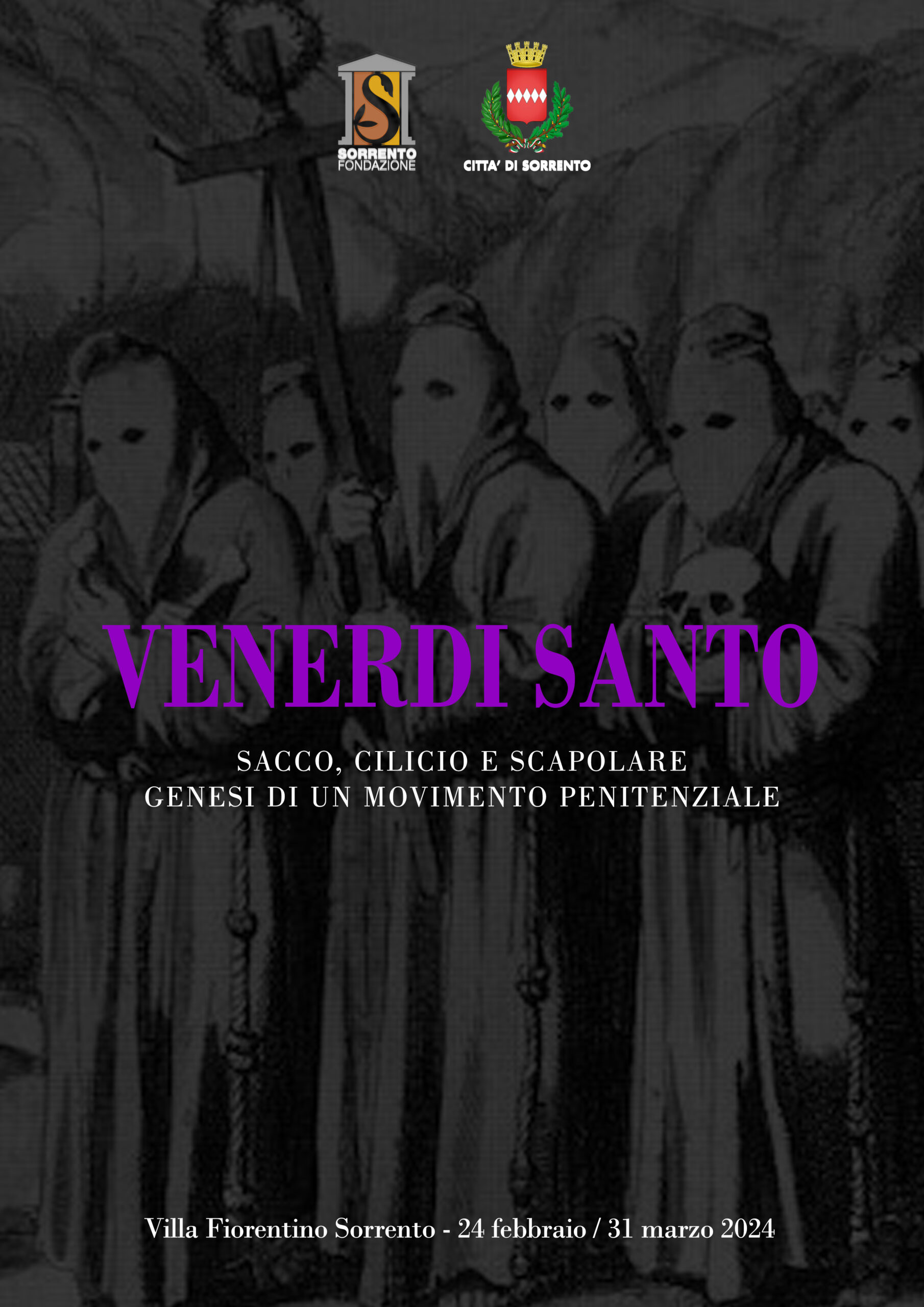PRESS RELEASE
The Sorrentine Peninsula, during Holy Week, encapsulates a sequence of events that showcase the history, faith, and traditions of a people who, at the dawn of the third millennium, still look with awe at a dusty village in Galilee, where Redemption was born.
This devotion reaches its climax in the numerous processions that are organized—evocative rituals centered around mysticism and popular religiosity. Hooded figures, lanterns, polyphonic choirs, bands with their poignant marches, crosses, symbols of the Passion, banners and gonfalons make the dies terribilis rich in pathos and sacred rituals.
This year, the Municipality and the Sorrento Foundation want to pay homage to these manifestations that characterize the faith of the inhabitants of the Coast through an exhibition set up in the rooms of Villa Fiorentino and curated by Massimo Fiorentino, prior of the Confraternity of Santa Monica in Sorrento.
An exhibition that, through images and symbols, aims to express the gratitude of the institutions and the population towards those who have kept alive the torch of knowledge that comes to us from time immemorial.
The exhibition not only focuses on the evocative rituals that animate the Coast but also highlights the activities of the brotherhoods in other countries bordering the Mediterranean, such as Spain.
Everything on display is authentic. Vintage albumen photos, engravings, watercolors, statutes of the associations are original.
The collection of many medallions is interesting. The exhibited material is the result of over fifty years of passionate research into everything related to the confraternal world.
Precious documents that allow new generations to discover a way of life that for centuries marked the lives of obscure confreres, with their participation in the obligations and various initiatives promoted by the pious associations.
To bring residents and tourists even closer to these fascinating cults, during the days of the exhibition, a rendition of the Miserere is scheduled on the stairs of Villa Fiorentino to allow everyone to attend.
An initiative that aims to retrace the deep religious sentiment that Sorrento and its peninsula have always had. From Vico Equense to Massa Lubrense, there are many churches and chapels, as well as convents and monasteries.
It is precisely in these places of worship that the brotherhoods arose, associations of laypeople with aims of piety and devotion, where, unlike monastic ones, associates are not obliged to live together and do not take vows. Their origin is uncertain, but they are certainly inspired by the mystical movement of the Flagellants or Disciplinants, from “disciplina,” a bunch of five cord-like strands, in remembrance of the wounds of Jesus, established by the hermit Raniero Fasani in Umbria in 1260.
When this movement waned, companies, or better yet, brotherhoods, were born and developed, all driven by a strong sense of religious association that pervaded every social class.
Depending on the regions, they were called fraternities, confraternities, guilds, collecta, sodalities, scholae, estaurite, congregations, companies, and centuries. The brotherhoods had a great spread between the fourteenth and eighteenth centuries, contributing to the social and cultural growth of society, building hospitals, hospices, orphanages, and conservatories.
Organizations that can be defined as descendants of medieval corporations. Much of their cultural heritage has come down to us, surpassing fashions and the difficulties of the present times.
“The confirmation of the existence of many brotherhoods on the Sorrentine Peninsula is also given by a decree of 1825 by Archbishop Gabriele Papa, from which it appears that at that time, there were fifteen brotherhoods in Sorrento, one in Capri, one in Anacapri, eight in the Massa Lubrense area, and eight in the Vico Equense area, along with three Monti dei Morti,” explains Prior Fiorentino. “In February 2024, there are 40 operating on the territory of the Sorrentine Peninsula. Most of them carry on the popular traditions of Holy Week, with rituals that involve a wide and solemn ceremonial. Each moment repeats with an unwritten script that everyone draws from, almost wanting to mark the sense of belonging to the territory. A strong, almost sacred bond with what represents an indissoluble thread that unites different generations. It is important to be there, to participate, to relive those pivotal moments that have so much of that feeling that nests in the so-called expressions of popular religiosity.”
And it is precisely these sentiments that the Villa Fiorentino exhibition aims to highlight.
“We are happy to host an event that will highlight the community spirit that has always bound the inhabitants of the Sorrentine Peninsula,” emphasizes the CEO of the Sorrento Foundation, Alfonso Iaccarino. “It is these ancient Easter rituals passed down from father to son that reflect the ancestral love that each of us has for our homeland. We are confident that the arranged path will awaken memories and emotions in visitors.“
“To engage in quality tourism, a goal particularly close to our administration since its inception, implies the rediscovery and enhancement of cultural identities and peculiarities of the territory,” adds Mayor Massimo Coppola. “And the rituals of Holy Week constitute a fundamental element of the identity and peculiarity of Sorrento and many other towns. Handed down from generation to generation, they have reached us; anyone who has the opportunity to witness them, whether a citizen or a tourist, is visibly struck, admired, and moved. The Villa Fiorentino exhibition collects and displays photographs and any other useful material so that the visitor can better understand the origins, nature, functions, and importance of the Holy Week rituals. I therefore thank everyone who, in different capacities, has contributed to the realization of the exhibition, and, in particular, I sincerely thank Massimo Fiorentino, who has volunteered to organize and coordinate the event.”
The exhibition, titled “Good Friday – sack, cilice, and scapular, genesis of a penitential movement,” will be open, free of charge, from February 24 to March 31, 2024, every day from 10 am to 1 pm and from 4 pm to 7 pm, while on Saturdays and Sundays, the closing time is extended to 8 pm.


